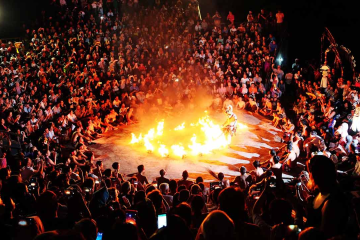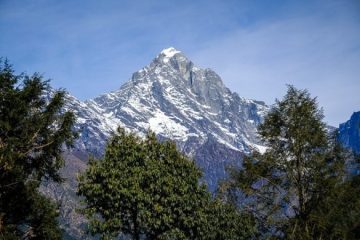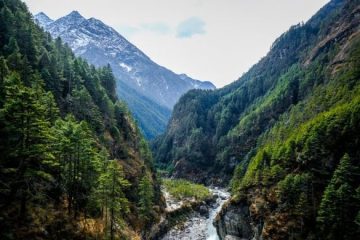This park covers more than 8,700 hectares (21,000 acres) of fantastic jungle, and there are hundreds of unique animal species living in the area.
The best part about the Tangkoko Nature Reserve is that it’s super easy to visit on a budget, and wildlife sightings are practically guaranteed.
This travel guide will explain how to get to Tangkoko, which lodges and guesthouses to stay in, and everything else you need to know before you go!
How To Get To Tangkoko National Park
The first step is to fly to Sam Ratulangi International Airport (code: MDC) in Manado, Indonesia.
Citilink has connecting flights to this airport from Singapore, and there are now direct flights from Bali (DPS) or Makassar (UPG). You can shop for flights to Manado at Skyscanner.
Tangkoko National Park is in north Sulawesi, about 60 kilometers (40 miles) east of Manado, but it takes about 1.5 to 2 hours to drive there because of the winding jungle roads.

Mount Klabat volcano hiding in the clouds. Tangkoko National Park is a 2 hour drive from Manado, Sulawesi.
• Tours From Manado To Tangkoko
If you want to simplify your visit to Tangkoko, Viator has a high-rated Tangkoko private tour starting from Manado.
This tour includes transportation to and from the Manado city area, park admission ticket for Tangkoko, and the ranger/guide fee, plus 10 hours of sightseeing in total. It’s a good value if you’re on a tight schedule and want to spend just one day visiting the park.
We’ve used Viator for lots of tours and activities around the world, and they’re great. Highly recommended!
Book Now: Tangkoko Private Tour
• Private Driver To Tangkoko
If you go to Tangkoko with a driver, the best and cheapest way to do this is to download the Go-Jek or Grab ride hailing apps.
Either app will work in the Manado area, but Go-Jek is usually cheaper and better. In my case, I used Grab car for this and the whole process went smoothly.
Hotels or lodges at Tangkoko Nature Reserve can usually provide a transfer if you ask, but the price will be quite a bit higher.
My guesthouse, the Tangkoko Hill Cottage, quoted 300k to 400k Rupiah ($20 to $27 USD) for a one way transfer from Manado to Tangkoko National Park.
A GoCar taxi ride with Go-Jek should be about half this price — usually less than 200k Rupiah. And then for the return journey to Manado, you can easily book a taxi from your hotel.
• Bemo Bus Service
If you happen to be traveling on a very thin budget there’s also a bemo bus service you can use to go from Manado to Bitung to Tangkoko, but it’s pretty complicated and may not be worth the extra time and hassle just to save a couple dollars.

• The Road To Tangkoko Nature Reserve
The good news is that the drive to Tangkoko gives you some incredibly scenic views of jungles and volcanoes.
Rows of palm trees cover the green hills, and the Mount Klabat and Mount Tangkoko volcanoes can be seen stretching up into the clouds.
It was an epic Indonesian landscape that made the 2 hour drive seem to go by in just a few minutes.

Visiting Tangkoko Nature Reserve
Guide & Entry Fees
The only way to visit Tangkoko park is on a guided walking tour that lasts about 4 hours.
Hiring a guide is required for this, but any hotel or lodge at Tangkoko can easily arrange a guide for you.
The guide fee is 200k Rupiah ($14 USD) for a morning hike, or 100k Rupiah for an evening hike, but these prices can be negotiated, especially if you go in a group.
There’s also an entry fee for the park that costs 100k Rupiah ($7 USD) for foreigners, and 5k for Indonesian residents.

The entry fee has to be paid each day you enter the park.
If you do multiple tours of Tangkoko on separate days then you will have to pay the guide fee and also the entry fee each time you visit.
The fees sound bad at first, and they’re definitely on the high side for what you’d normally expect in Indonesia, but I think the incredible wildlife you can see here makes it worthwhile.

Tangkoko Jungle Walk
The jungle walk is pretty straightforward and not strenuous at all.
It follows a flat path through the jungle that is mostly paved at first, and then at times cuts through the trees on a dirt path.
I wore shorts and sandals and somehow didn’t get any bug bites, but this was in the dry season and I sprayed myself with repellant.
I’ve heard of people getting lots of itchy bug bites here, so I’d recommend wearing bug spray and covering up your legs if you think it might be an issue. In the dry season you should have a bit more leeway.
The reserve is also known to have black tarantulas and occasionally venomous snakes (vipers), so you’ll want to watch your step and follow the guide at all times!

Tangkoko Wildlife
The biggest reason to tour Tangkoko National Reserve is to see the wildlife.
There are literally hundreds of Indonesian animal species living in the park, including a bunch of endemic species that only exist in Sulawesi.
I spent two days touring the park, and in total I saw at least 50 black Sulawesi macaques, rare birds (kingfishers, owls, and hornbills), lizards, snakes, cicadas, tarsiers, and more.
You can also see Cuscus bears and huge black tarantulas here.


• Sulawesi Crested Macaques
If you spend one or two days touring the park, you are almost guaranteed to see a bunch of the Sulawesi black macaques (the locals call them ‘yaki’).
These monkeys are endangered and can’t be found anywhere in the world outside of north Sulawesi and a handful of tiny islands near Sulawesi. Only about 5,500 of the monkeys are still living in Sulawesi.
If you’ve ever visited the Sacred Monkey Forest in Bali, you’ll be happy to hear that the Sulawesi monkeys are much more friendly and less aggressive than the Bali monkeys.
They won’t attack you or try to steal your stuff!


The macaques in Tangkoko park like to travel in ‘troops’ of about 25 monkeys.
There are two main troops living in the park, but only one of the troops is comfortable around humans and easy to photograph up close. The others wouldn’t let me get within 50 meters.
All of the baby macaques were extremely shy and I had a hard time getting a pic of one.


• Tarsier Spotting
Tangkoko Nature Reserve is one of the best places in Indonesia (or the whole world) to see endangered tarsiers.
These are the tiny, bug eyed primates that are usually very elusive and hard to approach.
They can sometimes be seen during the day, but generally the best time to see them is in the evening or at night when they wake up from their naps and come out to eat all the bugs.
I saw tarsiers during both of my jungle tours at Tangkoko and it was a special experience for sure! There are only a handful of countries where you can see these critters.


Tangkoko Black Sand Beach
If you have time, be sure to ask your Tangkoko guide if you can see the black beach.
This is a cool black sand beach created by the volcanic activity from Mount Tangkoko. The beach doesn’t have a name as far as I know, but it’s just a 5-10 minute walk from the entrance of the Tangkoko Nature Reserve.
Sometimes you can even see a group of the macaques hanging out on this beach.



How Long To Stay
If you really want a good chance to see plenty of wildlife (especially the tarsiers), then I would recommend spending at least two days at Tangkoko National Park.
Technically you could visit Tangkoko as a day trip from Manado, and come back to town in the same day, but I wouldn’t recommend this.
I spent two days and one night at Tangkoko Hill Cottage, and this was enough time to do two full tours (one in the afternoon and then another the next morning).
I saw lots of wildlife, including the macaques and tarsiers on both days. This also gave me enough time to visit the black sand beach at Tangkoko.
Where To Stay At Tangkoko
There are a handful of modest hotels near Tangkoko:
- Tangkoko Sanctuary Villa
- Tangkoko Hill Cottage & Resto
- Tangkoko Ranger Homestay
- Bird House Homestay Tangkoko
I had a great experience staying at Tangkoko Hill Cottage, which is located right by the park.
The host Frankie was super helpful with arranging walking tours for Tangkoko and finding a driver to take me back to Manado after I was done visiting the park.
Keep in mind all of the lodges near Tangkoko are guesthouse type accommodations with no WiFi, and even phone reception there is very limited, although the hotel owners can call a driver for you, etc if needed.

Other Tangkoko Tips
- Safety: I’ve traveled all over Sulawesi, both as a solo traveler and also later with my wife. The Manado area is very safe in general. Just take normal precautions. If you’re traveling alone, you can ask about joining a trekking group with other tourists.
- Mosquitoes: According to this Lancet study from 2018, Malaria is rare in this part of Sulawesi. I’ve never heard of a tourist getting Malaria from mosquitoes in Tangkoko or the Manado area. However, it’s still a good idea to sleep inside a mosquito net and wear repellant while out and about, just in case. Malaria can be nasty and dangerous.
Best Time To Visit
The climate of Indonesia is tropical, so the weather is hot and humid year round.
For north Sulawesi, the best time to visit is from May to November, when the conditions are more dry and sunny.
I went to Tangkoko Nature Reserve in mid-August and this turned out to be a great time to visit; there was no rain at all.
Happy travels!


See Also
- Most Beautiful Indonesian Islands – Best Places To Visit In Indonesia
- Best Hikes In Indonesia – Volcanoes, Jungles, & Waterfalls
- Indonesia Waterfall Guide – Best Waterfalls In Indonesia
- Indonesia Beach Guide – Best Beaches In Indonesia
- Best Things To Do In Indonesia – What To Do In The Islands
- Indonesia Travel Guide – Tips, Info, & Photos



0 Comments